In the vast realm of materials, ceramics stand as inorganic non-metallic solids shaped and solidified through high-temperature processes. These materials, ranging from the traditional to the advanced, exhibit a unique blend of toughness, corrosion resistance, and fragility. The term “ceramic” has expanded beyond its historical connotations to encompass a diverse array, including glass, silicon, and specific concrete systems. Let’s make sense of the ceramics diversification in this article.
What are ceramics?
Ceramics, encompassing a diverse range of materials, are integral components in various everyday products such as tiles, bricks, plates, glass, and even toilets. This expansive category, termed “ceramic materials,” is defined by the absence of organic substances, primarily those rooted in carbon-hydrogen bonds, and metallic elements. Comprising constituents like clay, minerals, oxides, and various compounds, ceramics emerge as the materials that remain once organic and metallic components are excluded.
One defining characteristic of ceramics is their refractory nature, signifying durability and the ability to withstand high temperatures, pressures, and resist most chemical compounds. Generally poor electrical conductors and mostly non-magnetic, ceramics exhibit a wide spectrum of mechanical properties, ranging from shattering easily to remarkable toughness.
Ceramics are categorized into two main groups: traditional, akin to those used in pottery, and advanced ceramics designed with specific engineered properties. Advanced ceramics are often engineered for hardness and durability. Shaped at moderate temperatures, ceramics undergo a high-temperature firing process, rendering them hard, durable, and resistant to heat, wear, and corrosion. The transformation into ceramics occurs when the material is no longer soluble in water, even under heat.
It’s crucial to distinguish between water solubility and porosity. While some ceramics may retain porosity, absorbing water, they remain non-water-soluble. Ceramics find applications in an extensive array of products, including tiles, bricks, engineering ceramics utilized in electronic devices, and aerospace components. This versatility underscores the significance of ceramics in both traditional and cutting-edge applications across diverse industries.
Distinguishing ceramics from pottery
Ceramics and pottery, though often used interchangeably, are distinct terms within the realm of materials. While related, they do not denote the same thing. Ceramics serve as the umbrella term, encompassing a broad spectrum of materials and products, with pottery representing just one subset.
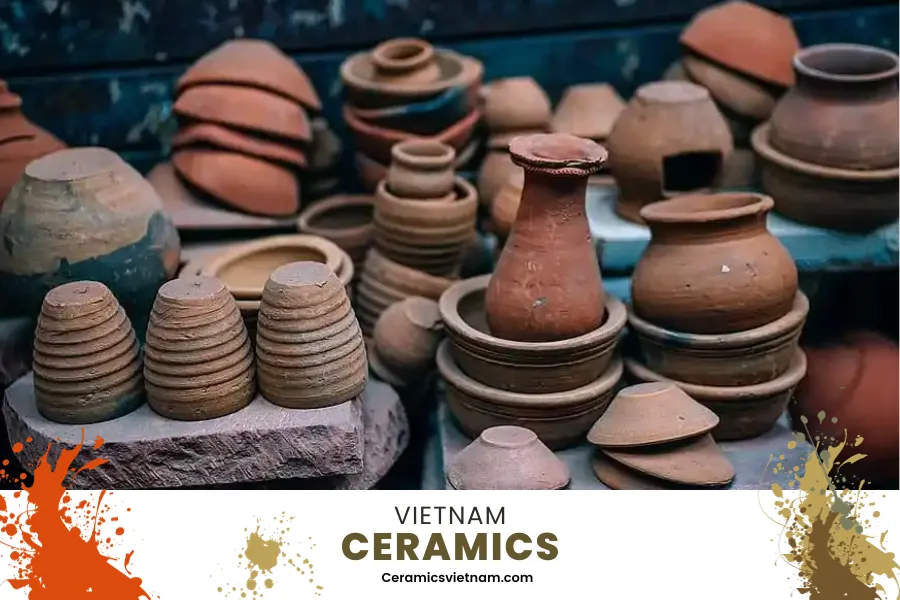
Distinguishing ceramics from pottery
Defining ceramics can be challenging due to its inclusivity. Various materials, including cement and bricks, fall under the ceramic category. Nevertheless, the fundamental definition of ceramics pertains to non-metallic and inorganic materials.
In contrast, pottery specifically denotes a category of functional containers fashioned from clay. Items like coffee mugs, vases, or cereal bowls fall under the umbrella of ceramic pottery. Beyond functionality, pottery can also serve artistic purposes. Notably, these utilitarian and artistic clay items represent some of the earliest forms of ceramics, earning them the classification of traditional ceramics. Therefore, while pottery is a form of ceramics, the broader term encapsulates a more extensive range of materials and applications.
Composition of ceramics
Ceramics are crafted from a blend of clay, earthen elements, powders, and water. This amalgamation undergoes a process of molding into the intended shape, followed by firing or heating to complete the manufacturing. The specific types and proportions of these materials vary, tailored to achieve the desired characteristics of the ceramic product.
The raw material for ceramics often involves pure clay, but the composition may be altered by incorporating additives like feldspar or silica to augment specific properties. This variability allows for customization, adapting ceramics for diverse applications. In instances where advanced ceramics are designed for specialized purposes, the materials used may extend beyond conventional compositions. Exotic substances such as tungsten carbide or zirconia might be employed to create ceramics tailored to meet the stringent requirements of specific applications.
Properties of Ceramics: Unveiling Inherent Characteristics
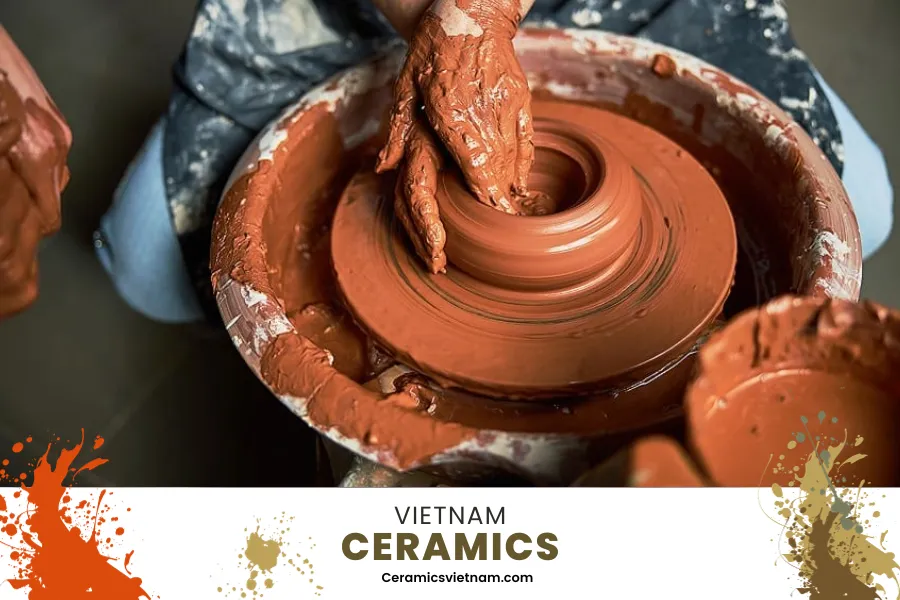
Properties of Ceramics: Unveiling Inherent Characteristics
The distinctive properties of ceramics, akin to any material, are intricately tied to the types of atoms present, the bonds that unite them, and their overall arrangement. This atomic architecture serves as the foundation for the material’s defining characteristics. Ceramics exhibit several key properties:
- Hardness and Brittle Nature: Ceramics are renowned for their hardness, surpassing that of metals. However, this robustness often comes hand-in-hand with increased brittleness, making them prone to fracture under certain conditions.
- Wear-Resistant: The inherent hardness of ceramics contributes to their exceptional wear resistance. This property makes ceramics ideal for applications where durability in the face of abrasion is crucial.
- Refractory: Ceramics excel in withstanding high temperatures, showcasing refractory properties. This resistance to heat makes them invaluable in applications involving elevated temperatures, such as in kilns and furnaces.
- Thermal and Electrical Insulation: Ceramics serve as excellent thermal and electrical insulators due to their atomic structure. This property finds applications in diverse industries, from insulating electrical components to facilitating controlled heating processes.
- Nonmagnetic: Unlike certain metals, ceramics are nonmagnetic. This property broadens their scope of applications, especially in environments where magnetic interference is undesirable.
- Oxidation-Resistant: Ceramics demonstrate resistance to oxidation, maintaining their structural integrity when exposed to oxygen and other oxidizing agents. This property contributes to their longevity and reliability in various settings.
- Chemically Stable: Ceramics showcase chemical stability, ensuring resilience against chemical reactions and degradation in the presence of different substances. This stability makes them suitable for applications requiring resistance to chemical corrosion.
In brief, the multifaceted properties of ceramics position them as versatile materials, finding applications across a spectrum of industries where their specific characteristics are harnessed for optimal performance and durability.
Type of ceramics
Ceramics, in the realm of materials, are inorganic non-metallic solids that undergo molding and solidification through high-temperature heating. They exhibit toughness, corrosion resistance, and a general fragility. In modern usage, the term “ceramic” has expanded to encompass a diverse array of materials, including glass, silicon, and certain concrete systems. Broadly, ceramics are divided into two main categories: Advanced Ceramics and Traditional Ceramics.
Advanced Ceramics: Referred to as technical, special, or high-performance ceramics, Advanced Ceramics are engineered to withstand challenging environments and demanding applications. These ceramics exhibit exceptional resistance to factors like temperature, melting, wear, and corrosion. Characterized by their inorganic, mostly crystalline nature, advanced ceramics are precisely manufactured with a well-regulated composition, including grain size and shape, phase distributions, and porosity. These materials are crafted with precision from highly refined and characterized raw materials, each possessing precisely defined properties.
Traditional Ceramics: Traditional ceramics, on the other hand, have a historical lineage, often derived from naturally occurring raw materials such as clay, quartz, and feldspar. The term “traditional ceramics” typically applies when the clay composition exceeds 20%. Examples include earthenware, stoneware, porcelain, and bone china. Clay, one of the most abundant raw materials, serves as the foundation for traditional ceramics. Different types of clay, along with variations in silica and other mineral content, yield diverse forms of pottery.
In essence, the evolution of ceramics spans from the classical and time-honored forms of traditional ceramics to the cutting-edge, precisely engineered solutions offered by advanced ceramics. This dual classification underscores the versatility and enduring significance of ceramics across various industrial and artistic domains.
Diverse type of Traditional ceramics
Crafted from clay, this collection features a variety of ceramics, including earthenware, stoneware, porcelain, and numerous other pottery types. The characteristics of the final product are influenced by factors such as the composition of the clays employed, the types of additives incorporated, and the temperatures during the firing process. Explore the different types within this collection to gain a deeper understanding of their unique qualities.
Earthenware
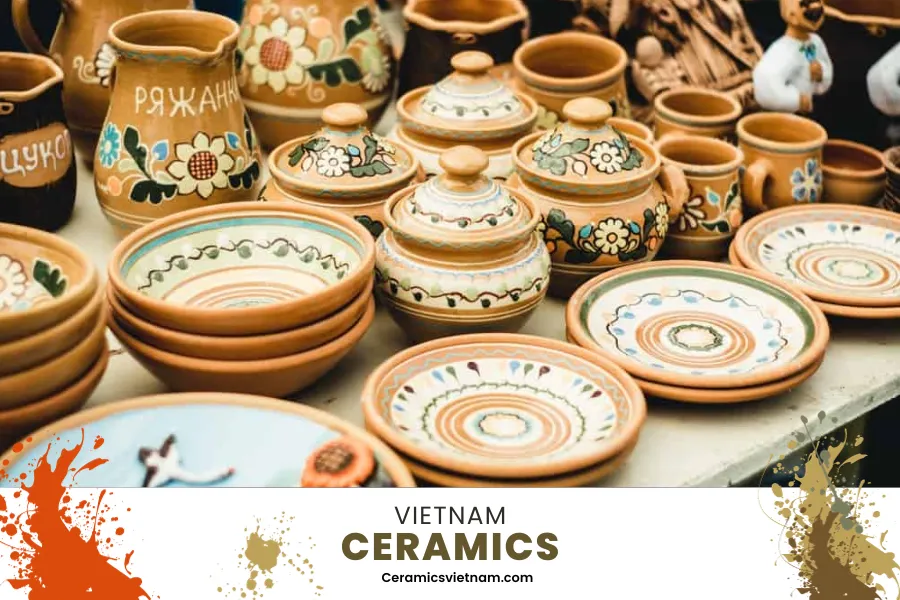
Earthenware stands as the oldest form of pottery, tracing its roots back to the Stone Age
Earthenware stands as the oldest form of pottery, tracing its roots back to the Stone Age. The composition of earthenware clay can vary, but a typical blend includes 25 percent ball clay, 28 percent kaolin, 32 percent quartz, and 15 percent feldspar. Fired at the lowest temperatures among pottery types, earthenware is known for its softness, porosity, and susceptibility to scratches.
To transform earthenware into waterproof objects, a vitreous (glass-like) liquid coating is applied, followed by a subsequent firing in the kiln. The iron content in the clay contributes to a spectrum of colors, ranging from buff to dark red, and even cream, grey, or black, depending on factors like the oxygen content in the kiln during firing. Although earthenware can achieve porcelain-like thinness, it falls short in strength, toughness, and porosity compared to stoneware.
Typically fired at temperatures between 1000-1200 degrees Celsius, earthenware encompasses a vast array of historical and cultural artifacts. It includes ancient pottery, terracotta objects, Japanese and Chinese pottery from the 16th century onward, as well as European pottery up to the 17th century. Noteworthy within this category is maiolica (faience or delft), a tin-glazed style of earthenware. One of the most illustrious examples of fine art earthenware is the renowned Chinese Terracotta Army, showcasing the craft’s aesthetic and historical significance.
Unlike vitrified pottery, earthenware retains its porous and coarse characteristics as it lacks the vitrification process, a phenomenon where crystalline silicate components form non-crystalline glass compounds. Until the 18th century, earthenware was the predominant form of pottery. Terracotta, an unglazed clay-based pottery, is a quintessential representation of earthenware and continues to find applications in contemporary settings, seen in planters, bricks, water pipes, and various construction materials. The legacy of earthenware, with its rich diversity and historical resonance, persists as a testament to the enduring artistry of this ancient craft.
Stoneware
Stoneware earns its name from the dense, stone-like quality it acquires after firing, rendering it impermeable and typically opaque. In its natural state, stoneware clay presents a grey hue, but the firing process transforms it into a light-brown or buff color, with the option for further hues through the application of glazes. Fired at temperatures generally ranging between 1100-1300 degrees Celsius, stoneware finds its place not only in commercial ware but also in the hands of artists like Bernard Leach, contributing to the creation of fine art pottery.
The origins of stoneware trace back to the Shang Dynasty in China around 1400 BCE, evolving and making its European debut in 15th-century Germany. The 17th century witnessed English ceramicists pioneering salt-glazed stoneware, setting the stage for advancements in the 18th century. Josiah Wedgwood, a luminary in the field, introduced black stoneware (basaltes) and the renowned white stoneware known as Jasperware.
Stoneware distinguishes itself as a vitreous or semi-vitreous product, often enameled to achieve a glassy appearance and nonporous quality. Fired at high temperatures, around 1200°C, the clay undergoes a transformation into a glass-like state (vitrified). The imperfections in the clay lend stoneware its characteristic earthy tone, and the non-porous nature allows for decorative glaze applications. Its durability, chip-resistant nature, and longevity make stoneware an ideal choice for kitchen essentials such as cooking, baking, storage, and serving dishes. Beyond mere functionality, stoneware stands as a testament to the artistry and enduring elegance achievable through the intricate fusion of craftsmanship and high-temperature alchemy.
Porcelain
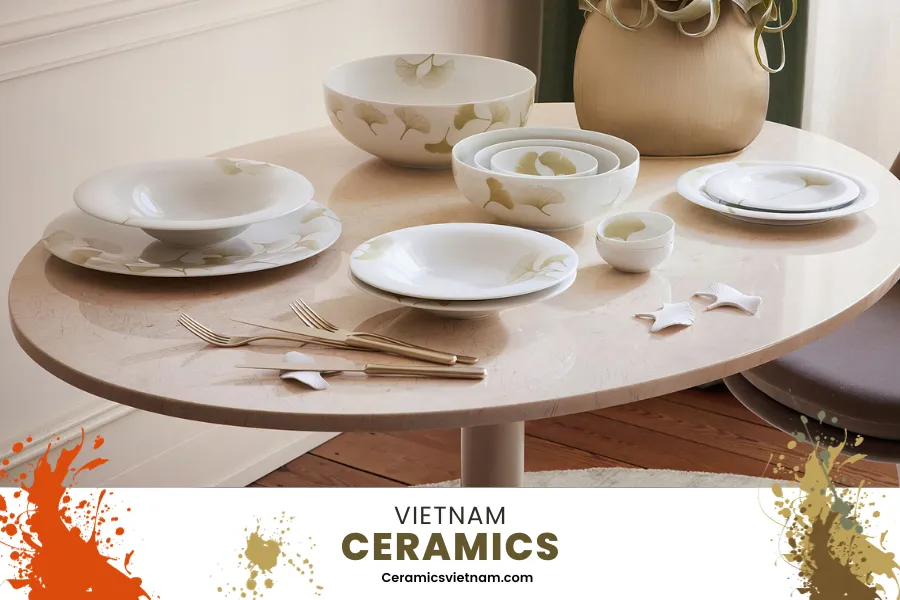
Porcelain’s versatility is showcased in various everyday items
The distinction between porcelain and stoneware is nuanced, with Chinese ceramicists defining porcelain by its distinct ringing tone and the West recognizing it for its characteristic translucence. According to the Combined Nomenclature of the European Communities, porcelain is differentiated by its greater translucence, while stoneware tends to be more opaque.
Chinese porcelain made its debut during the Han Dynasty (206 BCE-220 CE) or possibly later in the Tang Dynasty (618-906), utilizing kaolin (white china clay) and ground petuntse (a feldspathic rock). Subsequent refinements during the Song (960-1279), Yuan (1271-1368), and Ming (1368-1644) Dynasties elevated its artistry. In the 16th century, Florentine ceramicists attempted to emulate its translucence with ‘soft’ porcelain, but the true formula emerged in 18th-century Germany, led by ceramicist Ehrenfried Walter von Tschirnhaus and alchemist Johann Friedrich Bottger.
English ceramicists, including Josiah Spode, later introduced bone china by adding powdered bone ash to the German formula, creating a resilient and ivory-white type of porcelain. While the Continent favors German porcelain, bone china gained popularity in Britain and the USA.
Unfired porcelain clay can range from white to cream, while bone china clay remains inherently white. Post-firing, both exhibit a pristine white finish. These ceramics are manufactured by heating substances, typically kaolin clay, to temperatures ranging from 2,200 to 2,600 degrees Fahrenheit in a kiln. This process results in a heat-resistant and sturdy substance due to vitrification and the formation of mullite, a silicate mineral.
Porcelain‘s versatility is showcased in bathroom and kitchen tiles, containers, ornamental sculptures, and various everyday items. Its enduring elegance, refined over centuries, reflects the intricate craftsmanship and cultural legacy embedded in this remarkable material.
Bone China
Bone china, often referred to as fine china, stands as a pinnacle of translucent porcelain renowned for its exceptional strength and resistance to chipping. The inception of bone china is credited to the ingenuity of Josiah Spode around 1800, marking a transformative chapter in ceramic craftsmanship. This exquisite material is crafted from a blend of bone ash, feldspathic, and kaolin, a combination that bestows upon it unique characteristics.
One notable attribute of bone china is its remarkable translucence, a quality that sets it apart from other porcelain varieties. This inherent transparency is a result of the distinctive mineral composition, giving bone china a delicate and ethereal appearance when held up to the light.
The strength of bone china is a key feature that distinguishes it from traditional porcelain. Its robust nature allows for the creation of intricate and narrower shapes, expanding the artistic possibilities for designers and craftsmen. This durability, combined with its elegant translucence, makes bone china a preferred choice for fine dining and sophisticated tableware.
The legacy of Josiah Spode’s innovation endures in the refined beauty and functionality of bone china. Its delicate appearance belies its strength, making it not just a symbol of elegance but also a testament to the fusion of artistry and resilience in the world of ceramics.
Diverse application of Advanced ceramics
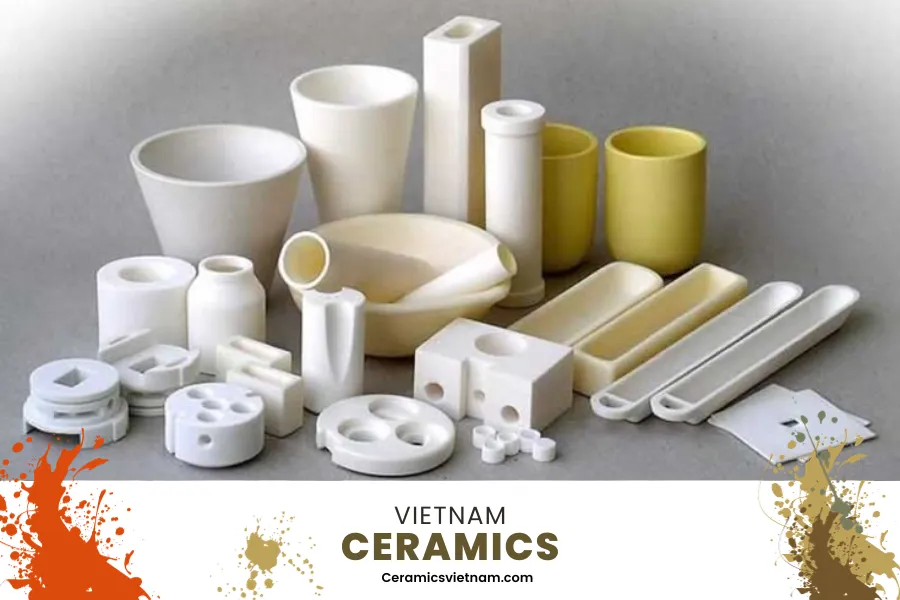
Diverse application of Advanced ceramics
These encompass all items crafted through a series of specialized manufacturing processes using inorganic, high-purity compounds. With applications spanning conductivity, magnetism, insulation, and heat transfer, they leverage oxides, non-oxides, or a blend of both. Delve further to explore the diverse array of types within this category.
- Aluminium Nitride (AlN) stands out for its exceptional thermal conductivity and resistance to thermal shock and corrosion. Its role extends to electronic applications, including high-frequency circuits, power electronics, and aerospace systems. Diamond (C), renowned as nature’s hardest substance, serves in industrial abrasives, cutting tools, and even jewelry.
- Lead Zirconium Titanate (PZT), a frequently used piezoelectric material, transforms electrical impulses into vibrations, playing a crucial role in gas igniters, ultrasonic imaging, and underwater detectors. Silica (SiO2), widely employed in engineering, contributes to thermal insulation, abrasives, and laboratory glassware, with additional applications in the communication industry’s optical fibers, tires, paints, and various products.
- Silicon Carbide (SiC), formed through sintering, finds its place in applications requiring exceptional endurance, such as vehicle brakes and bulletproof vests, owing to its remarkable hardness. Titanium Oxide (TiO2), commonly found in paints and glass ceramics, serves as a vital component in the creation of products like BaTiO3, contributing to sensors, ultrasonic transducers, and electronic components.
- Titanium Boride (TiB2), known for its excellent hardness, finds application in armor manufacture and exhibits outstanding electrical conductivity in diverse applications. Uranium Oxide (UO2), a black, radioactive crystalline powder occurring naturally, plays a pivotal role in nuclear reactors’ fuel rods, ensuring outstanding dimensional stability.
- Yttrium Aluminium Garnet (YAG, Y3Al5O12), primarily used in lasers, operates at room temperature with high slope efficiency, finding applications in military, medical, and meteorological fields. Zirconia (ZrO2), the strongest and hardest substance in its category, defies previous limitations, being employed in high-performance scissors, knives, ornamental applications, and jewelry for its diamond-like brilliance.
In conclusion, the saga of ceramics unfolds from the classical forms of traditional pottery to the precision-crafted solutions offered by advanced ceramics. This dual classification underscores the enduring significance and versatility of ceramics across industrial, artistic, and technological domains. Each type, whether rooted in history or forged through cutting-edge engineering, contributes to the rich narrative of ceramic craftsmanship.
Read more














Leave a reply